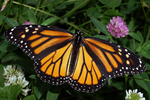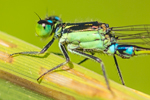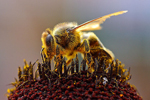A shocking new study finds that losing just one pollinator species could lead to major declines in plant productivity, a finding that has broad implications for biodiversity conservation. Looking at ten bumblebee species in Colorado alpine meadows, two scientists found that removing a single bee species cut flower seed production by one-third. Pollinators worldwide are in major trouble as they are hit by habitat loss, pesticides, disease and other impacts. In fact, the EU has recently banned several pesticides that have been linked to the global bee decline.
“We found that these wildflowers produce one-third fewer seeds in the absence of just one bumblebee species,” says lead author Berry Brosi, with Emory University. “That’s alarming, and suggests that global declines in pollinators could have a bigger impact on flowering plants and food crops than was previously realized.”
The study’s results, conducted in-the-field, contradicts past studies that have argued that plants would remain relatively unscathed in a world of fewer pollinators, so long as remaining pollinators picked up the slack. However, those past studies have depended solely on computer modeling; this new study is the first to test that hypotheses in real world conditions.
Brosi and his team set up plots at the Rocky Mountain Biological Laboratory in Colorado at 9,500 feet. In control plots, all ten bumblebee species were allowed to forage, while in other plots specific species were removed by net. A team of researchers then tracked the bees as they interacted with a flower called larkspurs.
“We’d literally follow around the bumblebees as they foraged,” explains co-author Heather Briggs with the University of California-Santa Cruz. “It’s challenging because the bees can fly pretty fast.”

A bumblebee (Bombus terrestris) covered in pollen. Photo by: P7r7/Creative Commons 3.0.
But why would removing one bee species out of ten have such an outsized impact on plant production? The key is in a pollinator’s fidelity to a specific plant species: pollination won’t occur unless a bee brings pollen from the same species.
“Most pollinators visit several plant species over their lifetime, but often they will display what we call floral fidelity over shorter time periods,” lead author Berry Brosi explains. “They’ll tend to focus on one plant while it’s in bloom, then a few weeks later move on to the next species in bloom. You might think of them as serial monogamists.”
However, the researchers found that by removing a single bee species, it upset the other bee’s fidelity. In control plots, 78 percent of bumblebees visited just one species of flower, leading to a much better pollination success rate. However, in the plots where a species was removed, only 66 percent of the bees were faithful to one flower. By removing a competitor the bees were more likely to visit a wider array of plant species.
“The small change in the level of competition made the remaining bees more likely to ‘cheat’ on the larkspur,” co-author Briggs notes.
The knock-off effect? Seed production dropped by 32 percent for lackspur flowers, an impact the scientists describe as “decreased ecosystem function.”
While the study was conducted in a few plots in Colorado, it could have implications worldwide.
“Our results suggest that ongoing pollinator declines may have more serious negative implications for plant communities than is currently assumed,” the researchers write. The study also provide another example of the importance of biodiversity altogether
“Our work shows why biodiversity may be key to conservation of an entire ecosystem,” Berry Brosi says. “It has the potential to open a whole new set of studies into the functional implications of interspecies interactions.”
Scientists have been warning for decades that the world is likely entering a new age of mass extinction with untold consequences. In recent years, pollinators have become in particular trouble. Over the last decade, bees have suffered from what has become known as Colony Collapse Disorder (CCD). Although a number of factors have likely played a role—including disease and loss of habitat—a flood of new research has pointed to pesticide-use as a key factor to the decline. Many butterfly species are also in decline—such as monarch butterflies-—while some species have vanished altogether. Despite their ecological importance, pollinators are often given less conservation and media attention than bigger, more “charismatic” endangered species.
CITATION: Berry J. Brosi, and Heather M. Briggs. Single pollinator species losses reduce floral fidelity
and plant reproductive function. PNAS. 2013.
Related articles
Losing our monarchs: iconic monarch butterfly down to lowest numbers in 20 years

(07/15/2013) In the next few months, the beating of fragile fiery orange and black wings will transport the monarch butterfly south. But the number of monarch butterflies (Danaus plexippus) reaching their final destination has steadily declined, dropping to its lowest level in two decades last winter, according to a recent survey.
Pesticides decimating dragonflies and other aquatic insects

(06/18/2013) While recent research (and media attention) has focused on the alleged negative impacts of pesticides on bees, the problem may be far broader according to a new study in the Proceedings of the US Academy of Sciences (PNAS). Looking at over 50 streams in Germany, France, and Australia, scientists in Europe and Australia found that pesticide contamination was capable of undercutting invertebrate biodiversity by nearly half.
EU labels another pesticide as bad for bees
(06/18/2013) A widely used insect nerve agent has been labelled a “high acute risk” to honeybees by the European Food Safety Authority (EFSA). A similar assessment by the EFSA on three other insecticides preceded the suspension of their use in the European Union.
U.S. loses nearly a third of its honey bees this season

(05/09/2013) Nearly a third of managed honeybee colonies in America died out or disappeared over the winter, an annual survey found on Wednesday. The decline—which was far worse than the winter before—threatens the survival of some bee colonies. The heavy losses of pollinators also threatens the country’s food supply, researchers said. The US Department of Agriculture has estimated that honeybees contribute some $20bn to the economy every year.
Widely used insecticide contaminating water supplies, triggering wildlife die-off in Europe
(05/03/2013) The world’s most widely used insecticide is devastating dragonflies, snails and other water-based species, a groundbreaking Dutch study has revealed.
Europe bans pesticides linked to bee collapse
(04/29/2013) The EU has banned three neonicotinoid pesticides (imidacloprid, clothianidin and thiamethoxam) linked to the decline of bees for two years. The ban will apply to all flowering crops, such as corn, rape seed, and sunflowers. The move follows a flood of recent studies, some high-profile, that have linked neonicotinoid pesticides, which employ nicotine-like chemicals, to the widespread decline of bees seen both in Europe and North America.
Domesticated bees do not replace declining wild insects as agricultural pollinators

(04/03/2013) Sprinkled with pollen, buzzing bees fly from one blossom to another, collecting sweet nectar from brilliantly colored flowers. Bees tend to symbolize the pollination process, but there are many wild insects that carry out the same function. Unfortunately, wild insect populations are in decline, and, according to a recent study, adding more honey bees may not be a viable solution.
Common pesticides disrupt brain functioning in bees
(03/27/2013) Exposure to commonly used pesticides directly disrupts brain functioning in bees, according to new research in Nature. While the study is the first to record that popular pesticides directly injure bee brain physiology, it adds to a slew of recent studies showing that pesticides, especially neonicotinoids, are capable of devastating bee hives and may be, at least, partly responsible for on-going Colony Collapse Disorder (CCD).